Description, cultivation, popular varieties of Savoy cabbage
Cabbage is on the list of products without which it is difficult to imagine the human diet. This vegetable has become the main ingredient in many national dishes and contains a large amount of useful substances. In our country, white cabbage is the most popular, while residents of Europe and the USA prefer Savoy cabbage. It appears more and more often on the shelves of our stores.
Savoy cabbage produces heads of cabbage, but not white, but dark green. Its leaves differ in texture, taste, and chemical composition from other types and subspecies of cabbage. There are also other characteristics of the vegetable with corrugated leaves.
General description of Savoy cabbage
Savoy cabbage is a subspecies of cabbage (white cabbage). It forms heads of cabbage, which eaten. There are also leaf varieties of Savoy cabbage (photo).
Photos and descriptions of this crop are difficult to confuse with other representatives of the Cruciferous (Cabbage) family. The leaves of the plant are thin, tender, without hard veins. Their shade varies from light green to emerald.
Heads of cabbage with grooved leaves are located on a high, powerful stem, covered with large leaf plates. From a distance they appear wrinkled.
The heads of cabbage are loose and easy to take apart. The upper leaves are thicker and have a richer green tint. Closer to the core they turn yellow.
The shape varies depending on the variety. It can be rounded-flattened, spherical, dome-shaped.Depending on the variety, the weight of the heads of cabbage varies between 0.5-3 kg.
This is interesting! The later the ripening period, the larger the heads of cabbage.
Savoy cabbage is highly frost-resistant. Young seedlings are able to withstand cold temperatures down to -4ºС, mature seedlings do not die when temperatures drop to -7ºС, adult plants can even be under snow and grow at temperatures down to -14ºС.
The Savoy variety is highly drought-resistant and undemanding to soil composition. It is capable of growing in clay, peaty and even saline soils.
The natural immunity of the plant is high. It is rarely affected by diseases and pests.
Due to its high frost resistance, the crop is suitable for cultivation not only in the southern regions of our country. It thrives in temperate climates, as well as in Siberia and the Urals.
The disadvantage of the cabbage variety is its relatively short shelf life when cut. Also, savoy cabbage is not suitable for pickling And pickling, since its tender leaves fall apart with this cooking method and do not turn out crispy.
Another disadvantage of the variety is its relatively low yield. Forks are light in weight, although they take up as much space on the site as white cabbages.
This is interesting! Savoy cabbage received its name in honor of the county of Savoy, where it was actively grown.
Popular varieties

The characteristics of Savoy cabbage largely depend on the variety. A large number of varieties and hybrids of this plant have been developed.
Vertue
Savoy cabbage Vertu with lace leaves is a mid-late variety. The head of cabbage has a flat-round shape. The color is dark, gray-green. The leaves are oval, vesicular.
Suitable for processing and fresh consumption. Shelf life up to two months.
The variety is distinguished by its demands on moisture and light. It cannot be called drought-resistant.
Golden early
This is an early variety - the heads of cabbage are cut 106-110 days after sowing the seeds. They have a spherical shape, reach a mass of 1 kg and a diameter of 60 cm. The outer leaves are light green in color, turning yellow towards the core. They have an openwork (bubbly) surface, highly corrugated.
The variety is highly resistant to drought, cracking, pests and diseases. From 1 sq. m harvest up to 4 kg of crop.
Moscow lacemaker
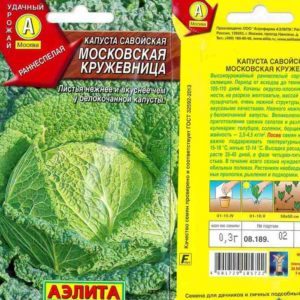
Early variety Moscow lacemaker. From emergence to harvest, 106-110 days pass.
The heads of cabbage have a rounded-flat shape. The leaves are yellow-green in color, round in shape, with lace-like blistering and wavy edges.
The weight of each head of cabbage varies between 1-1.5 kg. From 1 sq. m harvest up to 4.5 kg of crop.
Melissa
Melissa is a Savoy Dutch hybrid with medium ripening periods. It is highly resistant to fusarium and has powerful, well-developed roots.
Dense cabbage heads have a round shape. The leaves are medium corrugated with cuts, bubbly. The color is dark, gray-green. There is a thin waxy layer.
The weight of one head varies between 2-3 kg. From 1 sq. m harvest up to 5 kg of crop. The maximum shelf life is 5 months.
Pirozhkovaya

Early variety. It has high immunity and drought resistance. It contains a small amount of fiber, which is why its leaves are especially tender.
The head of cabbage has a cone-shaped shape. Density is average. Weight varies between 0.8-1 kg.
The outer leaves are emerald green and the inner leaves are yellow. They are wavy and bubbly.
Uralochka
Uralochka is a variety with medium ripening periods. Its main advantage is resistance to cracking.
The heads of cabbage are rounded, flattened, dense. The weight of each of them is approximately 2 kg.
The leaves are large, corrugated and vesicular. The upper layers are light green, and the central layers are yellow.
Differences between Savoy cabbage and regular white cabbage

Even though both savoy and white cabbage belong to the same family and look similar, they are different from each other. Their differences are as follows:
- Appearance. The leaves of regular cabbage are white and smooth, while savoy cabbage leaves are green and corrugated.
- Density, size and weight. White cabbage heads are denser, larger and heavier. They are more difficult to disassemble into leaves.
- Sustainability. Savoy cabbages are less likely to be affected by diseases and pests. They are characterized by high winter hardiness and drought resistance, in contrast to the white cabbage variety.
- Duration of storage. In this respect, Savoy cabbage is inferior to white cabbage.
Taste and application
White cabbage has thick, crisp leaves and rough veins. Over time, these qualities intensify. Savoy leaves are thin, without rough veins, tender.
Tastes also differ. Savoy cabbage does not have the bitterness characteristic of the white cabbage variety. The aroma is also different - it is not so sharp, but rich.
Corrugated cabbage leaves are especially tasty and healthy when eaten fresh in salads. They are suitable for stewing and preparing cabbage rolls. Moreover, if in a recipe with ordinary heads of cabbage the leaves are first boiled, then Savoy cabbage can be used raw.
Corrugated heads of cabbage are not suitable for pickling and pickling. In sour, salty brine, they become soft and not crunchy, and their taste deteriorates significantly.
Chemical composition and beneficial properties
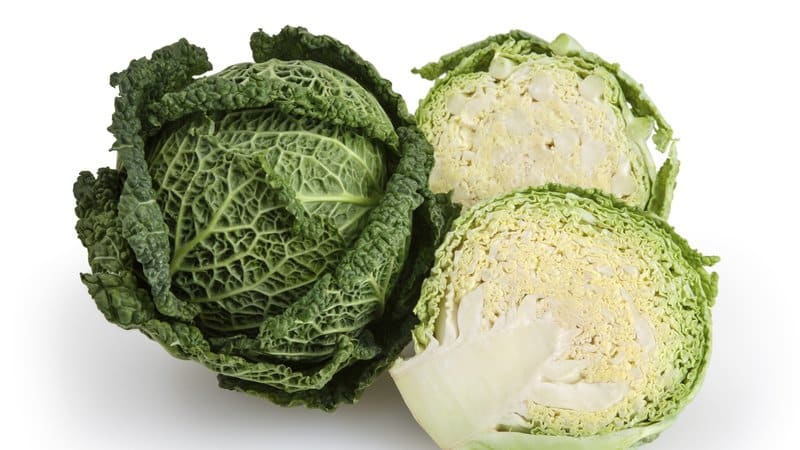
Savoy cabbage contains more nutrients than white cabbage. Among them:
- vitamins: B, A, C, E, K, U, D;
- minerals: iron, zinc, copper, potassium, selenium, magnesium, phosphorus, manganese, calcium;
- mannitol (sweeteners are made from it);
- essential amino acids;
- glutathione;
- sinigrin;
- ascorbigen.
The product has a wide range of useful properties. It is recommended to include it in the diet on a regular basis.
Beneficial features:
- normalizes the functioning of the gastrointestinal tract;
- activates immune processes;
- improves appetite;
- normalizes blood pressure;
- strengthens the nervous system;
- removes waste, toxins, free radicals from the body;
- prevents the formation of arterial plaques;
- tones the body;
- stimulates brain function;
- improves liver condition;
- accelerates tissue regeneration;
- improves metabolism.
The vegetable is recommended to be included in the diet of people suffering from diabetes and children. It is easily digestible and has virtually no contraindications.
Note! 100 g of product contains only 27 kcal.
Growing Savoy Cabbage
Growing ruffled cabbage is easy. This plant can grow in open ground in most regions of our country. The main thing is to take into account a number of rules and nuances.
Growing seedlings
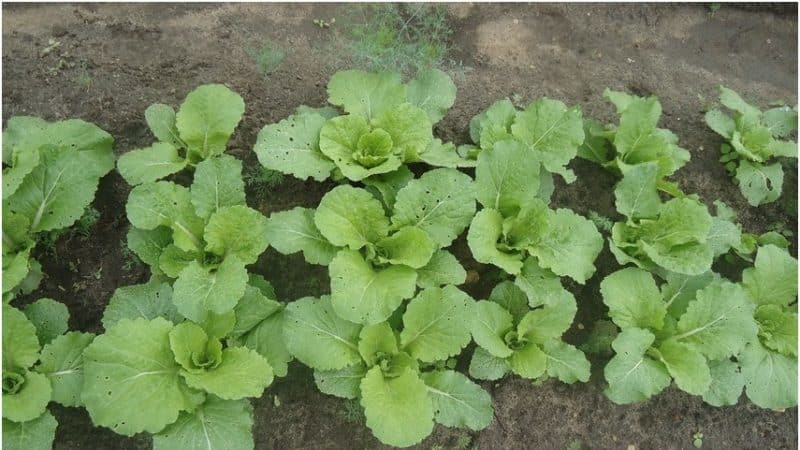
Experienced gardeners recommend growing cabbage in seedlings, despite its frost resistance. This allows you to get the harvest earlier. Seeds are sown from the second half of March to early April.
Before sowing, seeds are prepared:
- First, they are immersed in water with a temperature of +40...+50°C for 15 minutes, and then in ice water for 1-2 minutes.
- Planting material is disinfected. It is soaked for 30 minutes in a light pink solution of potassium permanganate.
- To speed up the appearance of the first shoots, planting material is soaked in a growth stimulator for 12 hours. After this, it is washed under running water.
- The planting material is kept on the refrigerator door for a day. Then dry until flowable.
To grow seedlings, buy universal soil or prepare a soil mixture from equal parts of garden soil, peat, and sand. The soil is disinfected with a dark pink solution of potassium permanganate or by calcination in the oven (180°C, 30-40 minutes). The same applies to containers.
Seeds are sown in boxes filled with soil mixture to a depth of 1 cm. A free space of 2-3 cm is maintained between the seeds.
The seeds are covered with sand. The soil is moistened with a spray bottle. Boxes with crops are covered with film and placed in a room with a temperature of +18...+20°C.
After a week, when the seeds germinate, the temperature is reduced to +8...+10°C. After another week, the greenhouse is dismantled.
After the first true leaf appears, the seedlings are planted in individual containers. In this case, a third of the central root is pinched off.
After picking, the seedlings are watered with a light pink solution of potassium permanganate. For four days it is kept in a shaded place at a temperature of +18...+20°C. Then the indicators are reduced to +12…+16°С.
Water the seedlings as the soil dries with warm, settled water. The liquid is poured under the root and used for spraying.
Plants are fed twice:
- Two weeks after picking into individual containers. Use special complex mineral fertilizers for seedlings.
- Two weeks before transplantation to a permanent place. A solution of potassium sulfate and urea is used.
Two weeks before planting in a permanent place, hardening of the seedlings begins, gradually increasing its duration. Cabbage is transferred to open ground in the second half of May.
Planting in open ground
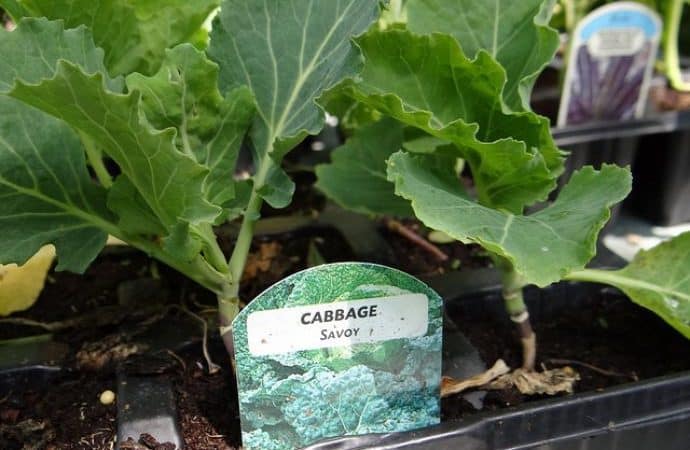
For planting cabbage choose a sunny area protected from the wind. No other cabbage family crops should grow on it during the past five years.
In the fall, the soil is prepared: it is dug up and cleared of weeds for every 1 square meter. m add 6 kg of humus, 30 g of superphosphate and 20 g of potassium salt. If the acidity of the soil is increased, add lime or ash. In the spring, the beds are dug up again, cleared of weeds and leveled with a rake. The holes are dug in rows in a checkerboard pattern, at a distance of 40-60 cm from each other.
Plants are buried down to the cotyledon leaves. The first two weeks of planting are protected from exposure to direct sunlight.
Advice. The smallest interval between holes is used for early varieties, and the largest for late varieties.
Care
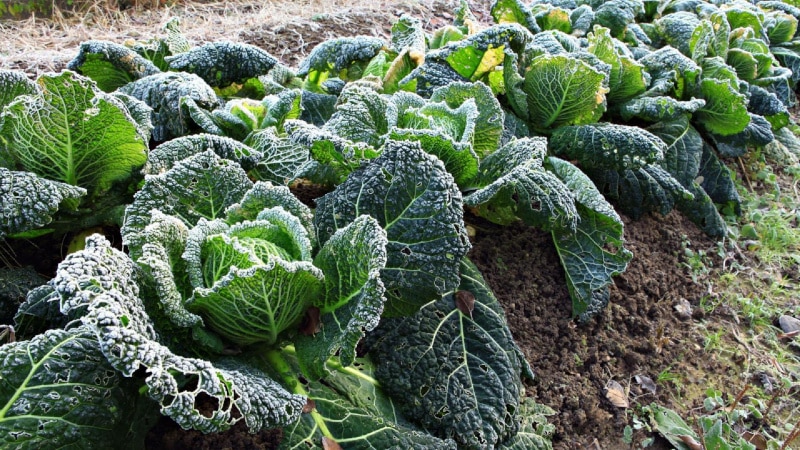
Caring for cabbage beds is easy. The main thing is to follow the basic rules of agricultural technology:
- Watering. For the first three weeks, the plants are watered from a watering can with settled water daily, spending per 1 square meter. m 7 liters of liquid. Next, the soil is moistened once every five days, spending 15 liters per 1 square meter. m.
- Loosening. After each watering and rainfall, the soil is loosened. During the loosening process, weeds are removed.
- Hilling. A month after transplanting, the cabbage is hilled up. For late varieties, the procedure is repeated again when the leaves close together.
- Feeding. For the first time, planting is fed with manure diluted 1:10, when the plant begins to grow.When heads of cabbage begin to form, phosphorus-potassium fertilizers are applied. For early varieties, two feedings are enough. Medium and late ones are fertilized for the third time a month after the previous feeding.
To preserve cabbage for as long as possible, in winter it is not cut from the stem, but buried under the snow right in the garden bed.
Reviews of savoy cabbage
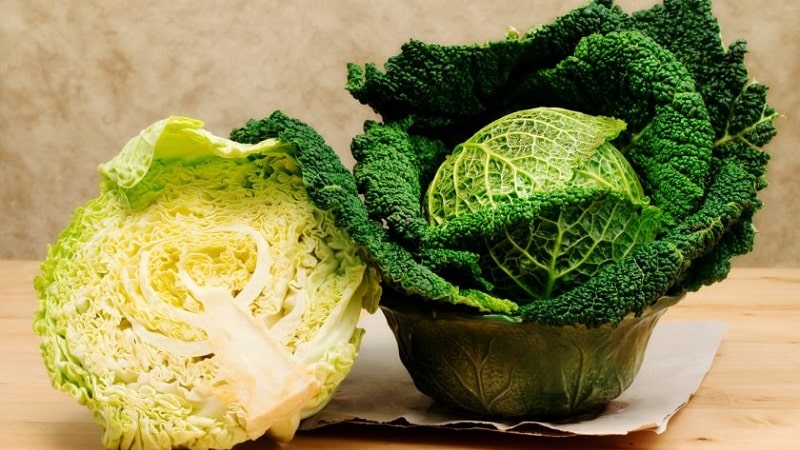
Reviews from people who have tried or grown Savoy cabbage are positive. This variety has many advantages over the usual white cabbage.
Irina, Voronezh: “I’ve been growing Savoy cabbage for three years now. It almost completely replaced the white cabbage for me. It is easy to grow. The main thing is to water and feed in a timely manner. At the same time, the taste is much more delicate, all dishes turn out tastier. Not suitable for fermentation only. In winter, I store it directly in the beds under snow or snobon. It doesn't affect the taste."
Alisa, Zelenograd: “I buy Savoy cabbage at the store instead of white cabbage. I love her very much. The vegetable is delicious both fresh and stewed with cheese and cream. I love making cabbage rolls and pies from it. It turns out more beautiful and tender than regular one. In addition, it has more beneficial properties.”
Conclusion
Savoy cabbage is an excellent analogue of white cabbage. It is characterized by high frost resistance and drought resistance. It is rarely affected by diseases and pests. In addition, the juicy corrugated leaves without hard veins have a delicate taste and contain a large amount of useful substances.
Growing Savoy cabbage is not much more difficult than ordinary white cabbage. The only thing that the plant is demanding is the timely application of fertilizing, watering and loosening of the beds.